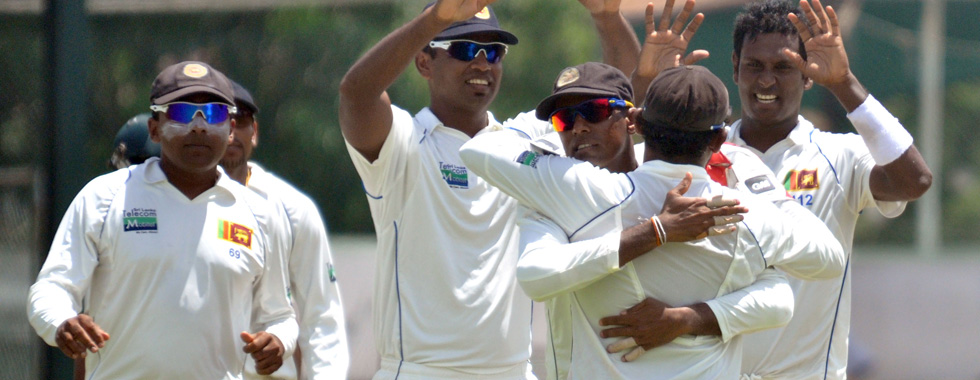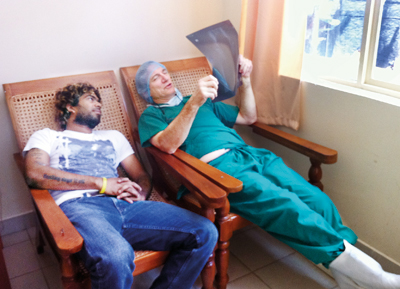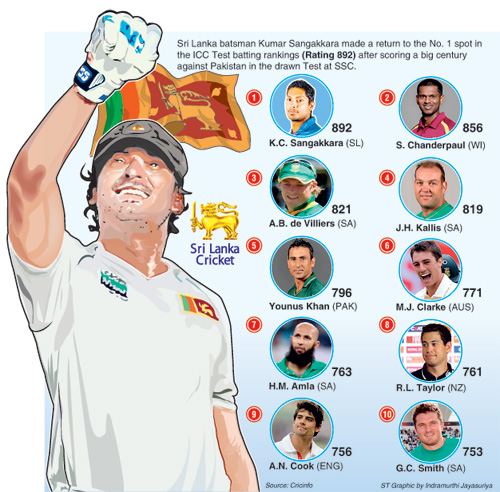Paycheck bouncer or players doosra?

Ironically these guys are going on without their pay cheque
While watching the final day’s play between Sri Lanka and Pakistan, I could not help noticing how sunburned Sangakkara looked. Sangakkara was fighting to save the day for Sri Lanka and take another step towards a series win, which the Lankans have been deprived of since the departure of Muttiah Muralitharan.
Yet, at the back of my mind I was also thinking that these guys have not yet signed their central contracts and they are delaying it, when it is their pay cheque that is the matter of discussion. Down Under, Cricket Australia reportedly ironed out its problems with its players after the matter worsened to extent of an impending strike action by the players if talks between the authorities and the Australian Cricketers’ Association had failed.
The situation at home is not hunky dory either. Since March this year, the authorities and the players have been wrangling about who gets what and how heavy their purse should be.There is no argument that cricketers are the lifeblood of the game. There can be actors and selectors behind the scene, but finally it is the cricketer who goes out into the middle and performs and it is his performance which dictates where his country is perched and that stand only sees to the P&L of the controlling organisation.
In short, Australian cricketers, who are the most consistent performers in world cricket today, get paid accordingly, and they too have problems.Here the crux of the matter is the survival of the game in the country.
For instance, last year it is said that Sri Lanka Cricket earned 1,800 million rupees and of that sum Rs. 1,100 million was allocated for player payments. The balance of Rs 700 million was spent on the maintenance and development of the game. With the commercialisation of the game, stakes have gotten higher and the player needs have become more complex. At the same time, with the advent of non-traditional income avenues like the IPL, the players too have found ways of sustenance. Now the problem is that once you hit the peak and become an individual player in the world forum, you find the income generated from your original source insufficient and the binding laws to get that tuppence not worth.
The Lasith Malinga saga is one of the best studies of this. While he was an emerging player, Malinga was humbled. He was sidelined because of an injury and was not even given the central contract which was offered to other national players. After much deliberation, a marginal amount was passed towards his upkeep. Subsequently, when he was given a contract, that allocation was deducted.
Sometime later, when he was performing well, he still was perched on a lower scale and was pushed up only after he protested.
Maybe when he retired from Test cricket the hurt must have been in him.
Then after blossoming in the IPL and becoming one of the brightest sons of Mumbai cricket, Malinga found the national contract insignificant. The 40% given to a player who does not indulge in Test cricket was not enough for Malinga, and last year he opted to play on without a central contract.This year he indicated that he may sign the contract if the authorities redesign his contract to suit his skills and contribution, and the matter has ended in a deadlock.
Now he plays only through the tour contracts, but says that he will prioritise his national obligations. That is one side of the coin.
Now the gap between the players and the organisation is the ICC fees. Generally the ICC gives member countries large sums of money for participation in ICC tournaments. From 2009, the players have stood to get 25% of that sum as their fee. This is where the differences lie at the moment. The SLC feels that it could do much more if this 25% goes toward a broader spectrum like development of infrastructure and other allied matters.
However, the players feel that it is they who have to keep the hearth aflame and the 25% of the ICC monies should be theirs. This is a catch-22 situation. The local controlling body needs the money to keep the development process alive and feels that this money should come to it to be used for development.The cricketers feel that it is their performances that bring in the ICC’s cash to the country.
At the same time this is the age where a local controlling body cannot afford to cross swords with players because it is the stars that get involved in matters of this nature and they can kick their central contracts like Lasith Malinga did. There is very little comparison between the one million ++ dollars that Mahela Jayawardena earns from the IPL to the hundred thousand ++ dollars that his central contract offers him for the year. So a player can contemplate his action as he is on a better footing than his employer, who binds him with so many clauses for that hundred thousand dollars. Ironically, last year, the employer did not even have the hundred thousand ++ to pay them and it is no secret as to how many metres of rubber was pulled before the emoluments were finally paid.
Freelance players are a new breed in the scene, and cricketers who are attached to poor boards like those of the West Indies and Sri Lanka may feel that they are better off remaining single and playing for the mushroom premier leagues, that are springing up all over. In the West Indies it has already happened and in Sri Lanka Malinga has shown the way.
Then looking at the scenario from a different perspective, the players too must begin to think more considerately. They must understand that they have reached this pedestal because their countries recognised their talent and gave them the opportunity over hundreds and thousands of other players.
Now that they have reached this point, they have the wherewithal to earn monies from events like the IPL. So if they could sacrifice some of their non-traditional emoluments outside the central contract they could be happy that the monies are utilised for the development of the game and the lot of tomorrow’s Mahelas and Sangakkaras.
Yet the players must also have seen and be aware of the corruption and waste which are going on behind the curtain.
They must be aware of what happened during the 2011 World Cup and how the authorities failed to bring to book any of the culprits who were seemingly responsible for the huge cash drought that Sri Lanka Cricket is facing today.
So when the crooked cart is running on a crooked road, can the players, who go out into that scorching sun and burn for days on end, feel sorry or feel that their sacrifices are going toward a worthy cause?We at this end think that first the house should be put in order before the players are put under stress.
comments powered by Disqus


















